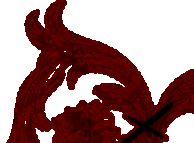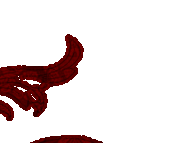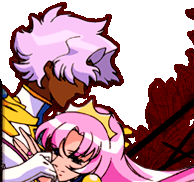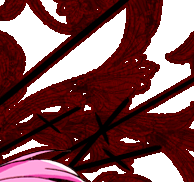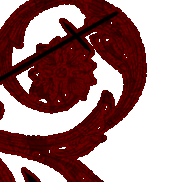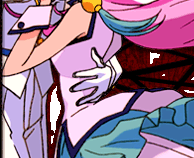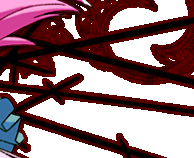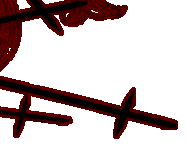
ADULTHOOD AND VILLAINY IN MATURITY
This analysis
was donated by Nicole K. Toivonen Winchester.

While magical girls may not ‘grow up’, the 1990s also saw an erosion of the shōjo-adult boundary, where many adult obligations – especially maternal and other domestic roles, as well as financial responsibility for the family – entered the magical girl’s everyday life, ranging from caring for a baby to building a supportive mother-daughter relationship.20 Romance, initially a reward after a farewell to shōjo-hood, it became integral to magical girls’ everyday school life.21 Saito says of the 1990s shōjo heroine’s increasingly busy life filled with responsibility, “many of today’s magical girl programs continue to provide young girls the opportunities to envision adulthood that fits the demands of the contemporary society.”22 Shōjo anime does the ideological work of teaching girls to envision marriage and domestic life as a desirable goal; shōjo has simply changed the image of marriage and domestic life to better match the needs of modern Japanese society.
Given this ideological indoctrination into life as a good wife and mother, the role of adult women in shōjo is a complex and contradictory one. As noted, Kotani recognizes that the “decidedly conservative male editors”23 defined the concept of shōjo through patriarchal constructs such as female virginity and the inevitability of heterosexual marriage. As a result, the concept of shōjo is often linked, even in the work of female writers, to the trope of the monstrous feminine that is common in male-authored science fiction. Particularly in shōjo manga, recurring conflict between older (that is, sixteen years old or older)24 and younger women often renders the older woman, who is sexually experienced but not sexually available, as monstrous. Meanwhile, the younger woman, who is sexually inexperienced, matures from an innocent shōjo who needs to be protected by a father figure into a more mature bishōjo on the cusp of sexual availability.25 This creates a limiting dichotomy between the roles offered to younger bishōjo and those available to older women.26 Young and cute bishōjo are heroes, older women are villains to be defeated. As Kathryn Hemmann notes, “This portrayal of the female villain as dangerous because of her mature sexuality is intensely problematic from a feminist perspective and recalls the common sci-fi dichotomy between the pure virgin and evil mother alluded to by feminist critics such as Susan Napier and Kotani Mari.”27 In shōjo, there is a similar dichotomy: the pure bishōjo and the ‘phallic mother’. Saito describes this concept:
Another primary type is the demonic older woman, the dark shadow cast by the unrelenting purity of the bishōjo. As a psychoanalyst, Saitō identifies this character type as the phallic mother, an expression “used to describe a woman who behaves authoritatively. The phallic mother symbolizes a kind of omnipotence and perfection.” …in the realm of shōjo manga, these qualities become signifiers of danger and villainy when applied to adult women… For a teenage female audience, an adult woman is both a frightening and pathetic creature. Her adult body is useless in the heterosexual economy of desire, her anger and frustration can change nothing, and any power she wields is unreliable and often misdirected. For such a woman, who has lost both her innocence and emotional clarity, “phallic” power is a dangerous thing that dooms her to the almost certain status of villainhood.28
Although ‘real’ power eludes the pure wide-eyed bishōjo until she enters the adult world, female adulthood in shōjo is a site of menace and evil, and the mature women that represent it, with narrow shaded eyes and phallic symbols of power,29 are simultaneously scary and sad.
Age is not the only thing that can make a girl or woman monstrous though; as Hemmann notes: “If a bishōjo grows too powerful, however, or if her magical or psychic powers are too obviously “a conduit for anger and oppressed female sexuality,” then “she is hunted” as a monstrous abnormality.”30 Thus, even in the most radical narratives, the two most dominant roles – mother and the shōjo – are governed by their relation to male sexuality.31 Even if there is a victor in the battle in this scenario, neither can truly win.
Go back to Index - Next Page
20 Saito, p. 157.
21 Saito, p. 157.
22 Saito, pp. 157–58.
23 Kotani, p. 167.
24 Saito, p. 157.
25 Kathryn Hemmann, ‘Short Skirts and Superpowers: The Evolution of the Beautiful Fighting Girl’, U.S.-Japan Women’s Journal, 2014.47 (2014), 45–72 (p. 57). 26 Hemmann, p. 56.
27 Hemmann, p. 63.
28 Hemmann, p. 63.
29 Hemmann, pp. 62–63.
30 Hemmann, p. 57.
31 Hemmann, p. 57.
 |

